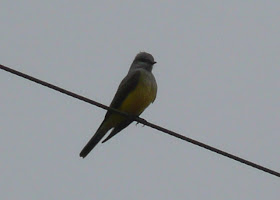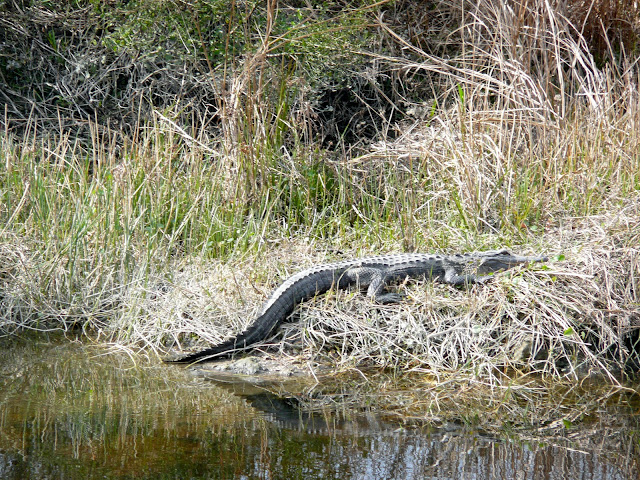 |
| West Inlet at Bunche Beach |
 |
| Spotted Sandpiper is best located near the west inlet at low tide |
Located large numbers of Willets and Marbled Godwits. Least and Western Sandpipers were active and a Spotted Sandpiper was located at the west inlet. Was able to count six Piping Plovers, about a dozen Black-bellied Plovers, a couple of Wilson's Plover and dozens of Semipalmate Plovers.
 |
| Black-bellied Plover |
Several Red-breasted Mergansers and a Common Loon were spotted in the bay along with Double-crested Cormorants. Looked through the Black Skimmers, Laughing Gulls, Ring-billed Gulls and Royal Terns for any herring gulls. No herring gulls today. Did have a lone American White Pelican amongst the Brown Pelicans. A flight of white pelicans was also seen overhead.
Had large numbers of Dunlins and Sanderlings and a few Ruddy Turnstones, plus a long Short-billed Dowitcher. Northern Cardinals, Palm Warblers and a House Wren were active back of the beach.
 |
| White Ibis |
My List -(36)
Red-breasted Merganser, Common Loon, American White Pelican, Brown Pelican, Double-crested Cormorant, Great Blue Heron, Great Egret, Snowy Egret, Tricolored Heron, Reddish Egret, White Ibis, Osprey, Bald Eagle, Black-bellied Plover, Wilson's Plover, Semipalmated Plover, Piping Plover, Spotted Sandpiper, Willet, Marbled Godwit, Ruddy Turnstone, Sanderling, Western Sandpiper, Least Sandpiper, Dunlin, Short-billed Dowitcher, Laughing Gull, Ring-billed Gull, Royal Tern, Black Skimmer, Mourning Dove, Fish Crow, House Wren, Gray Catbird, Palm Warbler, Northern Cardinal
 |
| Bunche Beach is famed for its birding |
 |
| Brown Pelican |
Returned to Bunch Beach on Saturday morning for the Lee County Bird Patrol walk. Had about a dozen participants and was lead By Charlie Ewell and Walt Winton. The birding Saturday was close to the experience on Wednesday, but we were able to add a resting Caspian Tern and about six Red Knots.
Charlie was able to photograph a banded Dunlin and a banded Red Knot. The following was a report Charlie recieved on the red knot's history since it was banded. Thanks Charlie!!!
Captures:
1/1/2007 11:45:00 AM - Sanibel Island - Bowman's Beach to Blind Pass, Florida, United States - 1172-98035 FLKY4 REKN
Resightings:
1/6/2007 - Fort Myers Beach, Florida, United States - 1172-98035 FLKY4 REKN
1/7/2007 - Sanibel Island- J.N Ding Darling NWR Wildlife Drive, Florida, United States - 1172-98035 FLKY4 REKN
3/12/2007 - Sanibel Island- J.N Ding Darling NWR Wildlife Drive, Florida, United States - 1172-98035 FLKY4 REKN
3/13/2007 - Sanibel Island- J.N Ding Darling NWR Wildlife Drive, Florida, United States - 1172-98035 FLKY4 REKN
9/15/2007 - Bunche Beach, Florida, United States - 1172-98035 FLKY4 REKN
12/18/2007 - Sanibel Island- J.N Ding Darling NWR Wildlife Drive, Florida, United States - 1172-98035 FLKY4 REKN
5/23/2008 - Mispillion Harbor, Delaware, United States - 1172-98035 FLKY4 REKN
5/23/2008 - Mispillion Harbor - Back Beach, Delaware, United States - 1172-98035 FLKY4 REKN
5/23/2008 - Mispillion Harbor - Osprey Point, Delaware, United States - 1172-98035 FLKY4 REKN
10/20/2008 - Fort DeSoto, North Beach, Florida, United States - 1172-98035 FLKY4 REKN
10/27/2008 - Fort DeSoto, North Beach, Florida, United States - 1172-98035 FLKY4 REKN
10/26/2009 - Longboat Key - at Diplomat Resort, Florida, United States - 1172-98035 FLKY4 REKN
3/6/2010 - Sanibel Island- J.N Ding Darling NWR Wildlife Drive, Florida, United States - 1172-98035 FLKY4 REKN
4/14/2010 - Kiawah Island - West, South Carolina, United States - 1172-98035 FLKY4 REKN
1/29/2011 - - 1172-98035 FLKY4 REKN
Charlie Ewell
My List - (34)
Red-breasted Merganser, American White Pelican, Brown Pelican, Double-crested Cormorant, Great Blue Heron, Great Egret, Snowy Egret, Little Blue Heron, Tricolored Heron, Reddish Egret, White Ibis, Osprey, Bald Eagle, Black-bellied Plover, Wilson's Plover, Semipalmated Plover, Piping Plover, Spotted Sandpiper, Willet, Marbled Godwit, Ruddy Turnstone, Red Knot, Sanderling, Western Sandpiper, Least Sandpiper, Dunlin, Short-billed Dowitcher, Laughing Gull, Ring-billed Gull, Caspian Tern, Royal Tern, Black Skimmer, Red-bellied Woodpecker, House Wren

































